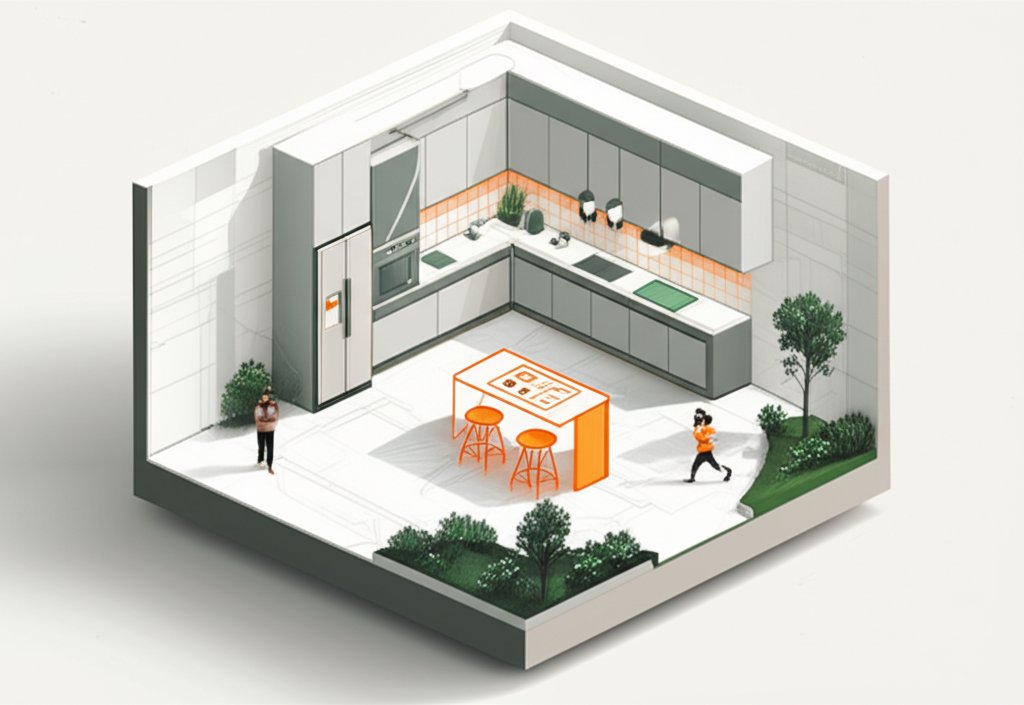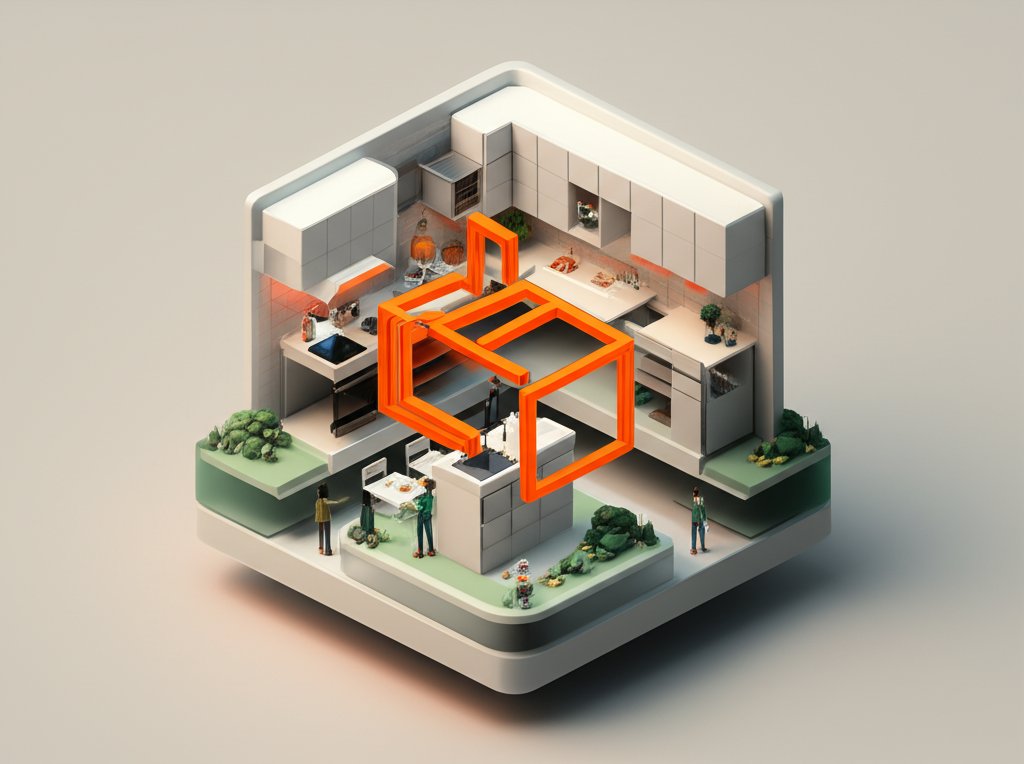That awkward corner where the counter ends? The endless search for the right spice in a crammed cabinet? A kitchen island, built with smart island cabinets, can solve these problems and become the heart of your home. You don’t need a custom kitchen designer, either. With a little planning and readily available stock cabinets, you can create a functional and beautiful island that perfectly fits your needs and style.
At a glance:
- Expand your workspace: Islands add valuable counter space for food prep, baking, or even a casual dining spot.
- Boost storage: Clever cabinet configurations maximize storage for everything from pots and pans to cookbooks.
- Customize your style: Choose cabinet styles, colors, and hardware to match your existing kitchen or create a bold new look.
- Save money: Building with stock cabinets is a budget-friendly alternative to custom cabinetry.
- Increase your home’s value: A well-designed kitchen island is a sought-after feature for homebuyers.
Why Build an Island with Stock Cabinets?
Let’s face it: kitchen renovations can be expensive and disruptive. Custom islands are beautiful, but they often come with a hefty price tag and long lead times. That’s where the beauty of using stock cabinets comes in. Stock cabinets are mass-produced in standard sizes and styles, making them readily available and significantly more affordable. This doesn’t mean you have to sacrifice style or functionality. With a little creativity, you can combine stock cabinets to create a custom-looking island that meets all your needs.
Planning Your Island: Size, Layout, and Functionality
Before you start ordering cabinets, take some time to plan your island carefully. Consider these crucial factors:
- Size and Clearance: The size of your island should be proportional to the size of your kitchen. You need enough space to move around comfortably. A good rule of thumb is to allow at least 42 inches of clearance between the island and surrounding countertops in a single-cook kitchen. If multiple people will be cooking at the same time, increase that to 48 inches. If wheelchair accessibility is needed, aim for 60 inches to allow for comfortable turning.
- Functionality: How will you use your island? Will it primarily be a prep space, a dining area, or a storage hub? Do you need a sink, a cooktop, or a wine fridge? Thinking about your needs will help you determine the best cabinet configuration.
- Layout: Decide on the overall shape and layout of your island. A simple rectangular island is the easiest to build, but you can also get creative with L-shaped or U-shaped designs. Consider the placement of doors and drawers for easy access.
Choosing the Right Stock Cabinets: Style and Construction
Stock cabinets come in a wide variety of styles and materials, so you’re sure to find something that fits your aesthetic.
- Style: Consider the overall style of your kitchen. Do you prefer a traditional look with raised-panel doors, or a more modern style with shaker or slab doors?
- Material: Stock cabinets are typically made from plywood, particleboard, or MDF. Plywood is the most durable option, but it’s also the most expensive. Particleboard and MDF are more affordable, but they may not be as resistant to moisture and wear.
- Construction: Look for cabinets with solid construction, sturdy drawers, and smooth-gliding hardware. Dove-tail joints are a sign of quality craftsmanship.
Decide on traditional or transitional stock cabinets. Choose a door style, like shaker or square. Select pulls or knobs from a huge range of finishes and designs
Essential Tools and Materials
Before you start building, gather the necessary tools and materials. Here’s a basic list:
- Stock cabinets: Choose the size and style that fit your design.
- Plywood: For building the base and end panels.
- Poplar boards: For the base frame.
- Fasteners: Wood screws, nails, and construction adhesive.
- Tools: Circular saw, miter saw, drill, screwdriver, nail gun (optional but helpful), level, measuring tape, clamps, sandpaper, paint or stain.
- Countertop: Choose your preferred material (laminate, butcher block, solid surface, granite, etc.)
- Finishing supplies: Primer, paint or stain, sealant, wood filler.
Step-by-Step Guide: Building Your Island Cabinets
This is a general outline, and you may need to adjust the steps based on your specific design.
- Build the Base Frame: Cut the poplar boards to size and assemble the base frame using wood glue and screws. This frame will provide a solid foundation for your island.
- Create the Bottom, Back, and End Panels: Cut the plywood to size and attach it to the base frame using glue and screws. The bottom panel will support the cabinets, while the back and end panels will enclose the island.
- Attach the End Stiles and Rails: These create a decorative frame around the end panels. Cut the boards to size and attach them with glue and nails. Test the length by placing the remaining stile against the end of the rails. If the stile overhangs the plywood, the rails are too long and need to be trimmed.
- Assemble the Cabinet Base: Stand the ends upright and attach them to the base/back assembly. Drive screws strategically to minimize the need for wood filler later.
- Add Pilasters (Optional): Pilasters are decorative vertical elements that can add a touch of sophistication to your island. Cut them to length and attach them to the cabinet ends.
- Install the Cabinets: Position the stock cabinets on the base and secure them with screws. Make sure the cabinets are level and flush with each other.
- Add the Front Rail: Cut a front rail to match the overall length of the island and attach it to the base, flush with the top of the plywood bottom.
- Install Corner Stiles: Add corner stiles to the front of the ends for a finished look. Glue and nail the stiles to the front of the ends
- Cut and Install the DIY Kitchen Island Shelf Cleats: Cut four 3/4-inch square dowels 11-1/4 inches long for the shelf cleats (L). Glue and nail them in place (Project Diagram, Drawing 3) and attach with glue and nails. The key to setting the cleats at the same height so the shelves are level is to cut scrap boards 11 inches long. Then rest one shelf on the bottom (C) and then glue and nail a cleat while it rests on a spacer. Move the spacer up to position the next cleat and repeat for the opposite side. The cleats can be positioned at whatever height you need to customize your storage needs.
- Add Shelves (Optional): Cut shelves to fit inside the cabinets for added storage.
- Attach End Panels: Cover the exposed sides of the cabinets with decorative end panels.
- Install Base Trim: Use your miter saw to cut a miter on each end of the base trim (N) so it fits between the pilasters. Glue and nail the trim even with the bottom of the cabinet
- Install the Countertop: Attach the countertop to the cabinets using construction adhesive or screws.
Remember to follow all tool manufacturer instructions for use and safety, including specifications for safety gear.
Finishing Touches: Paint, Hardware, and Accessories

Once your island is built, it’s time to add the finishing touches.
- Paint or Stain: Sand all the parts with 150-grit sandpaper and make sure all of the edges are smooth. This includes sanding a 10-foot-long piece of base shoe that’ll be used after the island is installed in your kitchen. Lightly sand the entire cabinet with a 220-grit sanding sponge and fill any nail holes with wood filler. Allow the filler to dry and lightly sand again. Primer and paint the island to match your kitchen. Alternatively, you can stain the wood to highlight its natural beauty.
- Hardware: Choose knobs and pulls that complement your style.
- Accessories: Add towel bars, spice racks, or other accessories to customize your island.
After the adhesive cures, add the doors and shelves.
Strategic Placement for Maximum Kitchen Efficiency
Strategic placement transforms your kitchen’s efficiency by creating intuitive pathways between key work zones. When positioned correctly, an island can reduce the steps required for meal preparation by up to 30%, while poor placement can increase fatigue and frustration during even simple tasks. The National Kitchen and Bath Association emphasizes that islands should enhance the work triangle – the path between your sink, stove, and refrigerator – rather than obstruct it.
The standard recommendation of 42 inches for single-cook kitchens and 48 inches for multi-cook spaces represents more than arbitrary measurements – it reflects decades of ergonomic research and real-world testing. These clearances accommodate the full swing of dishwasher doors, the pull-out radius of large drawers, and the space needed for two people to pass comfortably while carrying hot dishes or sharp knives.
Maximizing Storage with Smart Cabinet Design
You’re building a kitchen island from cabinets, so you’re also extending your storage space for cookbooks, dishes, serving pieces and more. Strategic cabinet design can maximize every precious square inch of storage potential. Modern cabinet interiors go far beyond simple shelves to create specialized environments for different types of items.
When every item has a logical home within your island’s cabinet system, meal preparation becomes more intuitive and less stressful. Deep drawers maximize accessibility for heavy pots and small appliances. Vertical dividers keep flat items organized and prevent sliding
Pull-Out Systems: The Evolution of Island Storage
Specialized pull-out systems represent the evolution of kitchen island cabinets from static storage boxes to dynamic, user-responsive environments. Upgrade Your Kitchen Island with options like spice pull-outs, heavy-duty appliance slides, and waste/recycling pull-outs. These mechanisms solve the fundamental problem of deep cabinet spaces where items disappear into dark corners, creating frustration and wasted space.
Planning for Utilities: Electrical, Plumbing, and Gas
Planning for utilities must happen early in the design process, as retrofitting electrical, plumbing, or gas lines after cabinet installation becomes exponentially more complex and expensive. Consider future needs as well – installing extra electrical circuits or water lines during initial construction costs far less than adding them later. If you are including a cooktop, coordinate with professionals for safe cooktop installation
Cost Considerations: Stock, Semi-Custom, and Custom

Stock cabinets typically cost $100-$300 per linear foot and offer the advantage of immediate availability and standardized quality control. Semi-custom options, ranging from $200-$600 per linear foot, provide more flexibility in dimensions and interior configurations while maintaining relatively predictable timelines and costs. The total cost of ownership extends beyond initial purchase price to include installation, finishing, hardware, and long-term maintenance.
Electrical Outlets: Safety and Convenience
The National Electrical Code requires at least one GFCI-protected outlet for islands with countertop space measuring 24 inches or longer. The placement of outlets requires balancing accessibility with aesthetics, leading to innovative solutions like pop-up outlets that remain hidden when not in use and under-cabinet outlets that serve appliances without cluttering the backsplash. Arc-fault circuit interrupters (AFCIs) provide additional protection against electrical fires caused by damaged wiring or loose connections.
Creating Comfortable Seating
Creating comfortable seating within your Consider these options: Kitchen Islands with transforms the space from a purely functional work zone into the social heart of your home. Ergonomic considerations vary significantly between counter-height and bar-height seating, with each option offering distinct advantages and challenges. Aisle clearance should be a minimum of 36 inches behind seating for comfortable passage.
Lighting Options: Task, Ambient, and Accent
LED strip lights offer even illumination and energy efficiency, while puck lights provide focused spots for specific work areas. Interior cabinet lighting transforms storage from hidden compartments to display opportunities, making it easier to locate items while adding visual interest to glass-front doors or open shelving. Toe-kick lighting adds both safety and sophistication, providing gentle pathway illumination that prevents stumbling in low-light conditions while creating the illusion that the island is floating above the floor.
Integrating Waste Management
Integrating waste management into your kitchen island cabinets addresses one of the kitchen’s most necessary yet aesthetically challenging functions. Consider pull-out systems to maximize space and hide unsightly bins.
Common Questions About Island Cabinets:
- Can I use different depths of stock cabinets to create a multi-level island? Yes, you can! This is a great way to add visual interest and create separate zones for prep and dining. Just make sure to properly support the countertop overhang.
- What’s the best way to attach the island to the floor? In most cases, the weight of the cabinets and countertop is enough to keep the island in place. However, if you’re concerned about stability, you can use shims to level the island and then secure it to the floor with screws.
- How do I handle plumbing and electrical if I’m adding a sink or cooktop to the island? This is best left to the professionals. Hire a licensed plumber and electrician to ensure that the wiring and plumbing are installed safely and according to code.
- What are some creative storage solutions for island cabinets? Think beyond basic shelves. Consider pull-out drawers, spice racks, utensil organizers, and even a built-in wine rack. Vertical dividers are excellent for storing baking sheets and cutting boards. kitchen island base without top, you have even more freedom to customize the storage yourself!
Your Next Steps: Designing the Island of Your Dreams
Building an island with stock cabinets is a rewarding project that can transform your kitchen. Start by carefully planning your design, choosing the right cabinets, and gathering the necessary tools and materials. Don’t be afraid to get creative with the finishing touches to create a truly unique and personalized space. Explore prefab kitchen islands for inspiration. With a little effort, you can create an island that’s both functional and beautiful, enhancing your kitchen and your home life. Building your own unique island cabinet solution is possible.
- Glass Wall Tile Ideas for Kitchens and Bathrooms - December 6, 2025
- Glass Tile Bathroom: Create a Beautiful, Easy-Clean Space - December 5, 2025
- Glass Tile: Brighten Your Home With Stylish Glass Backsplashes - December 3, 2025










